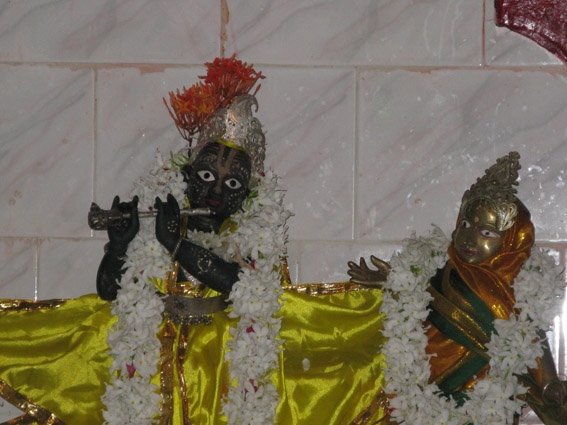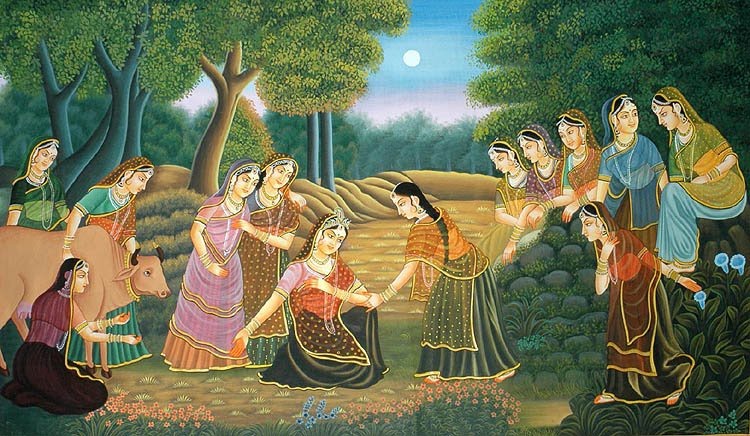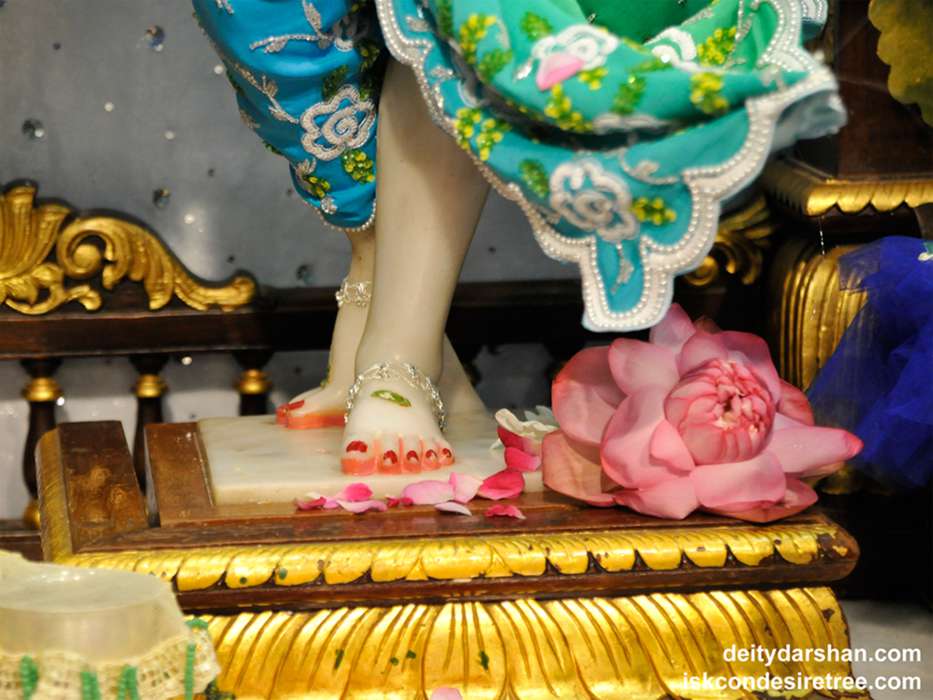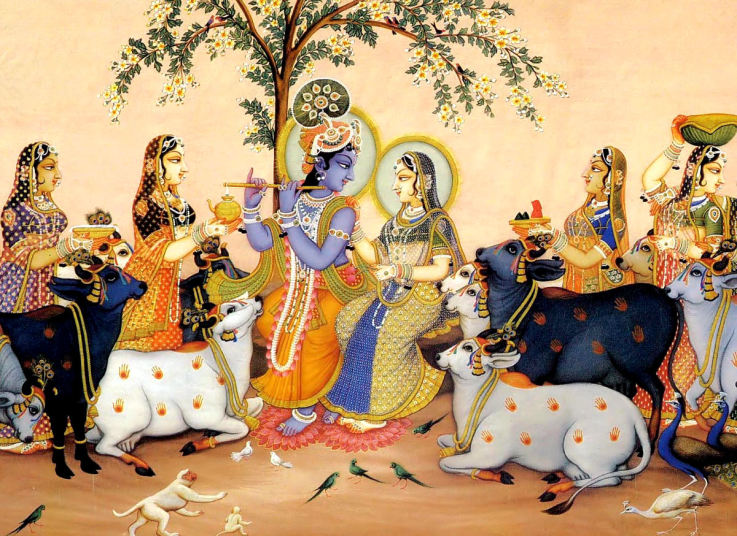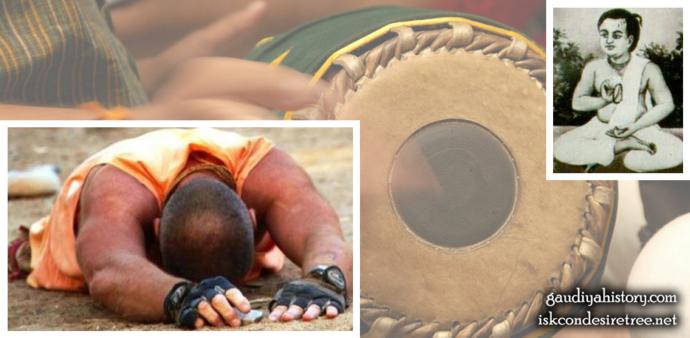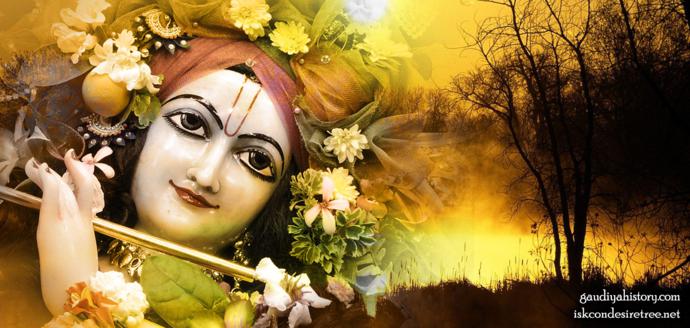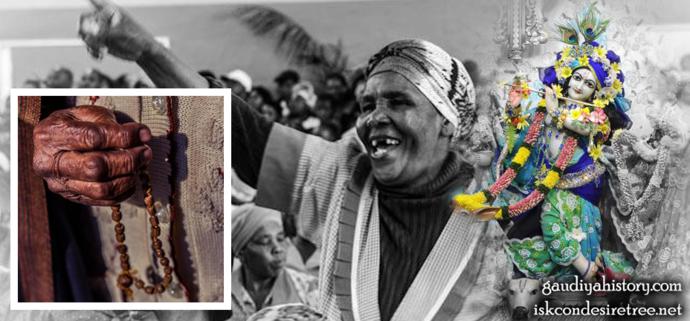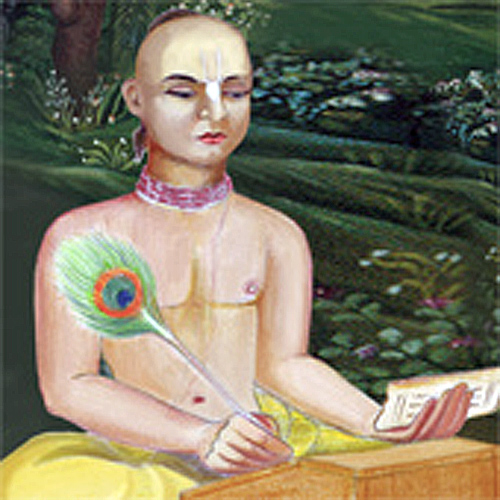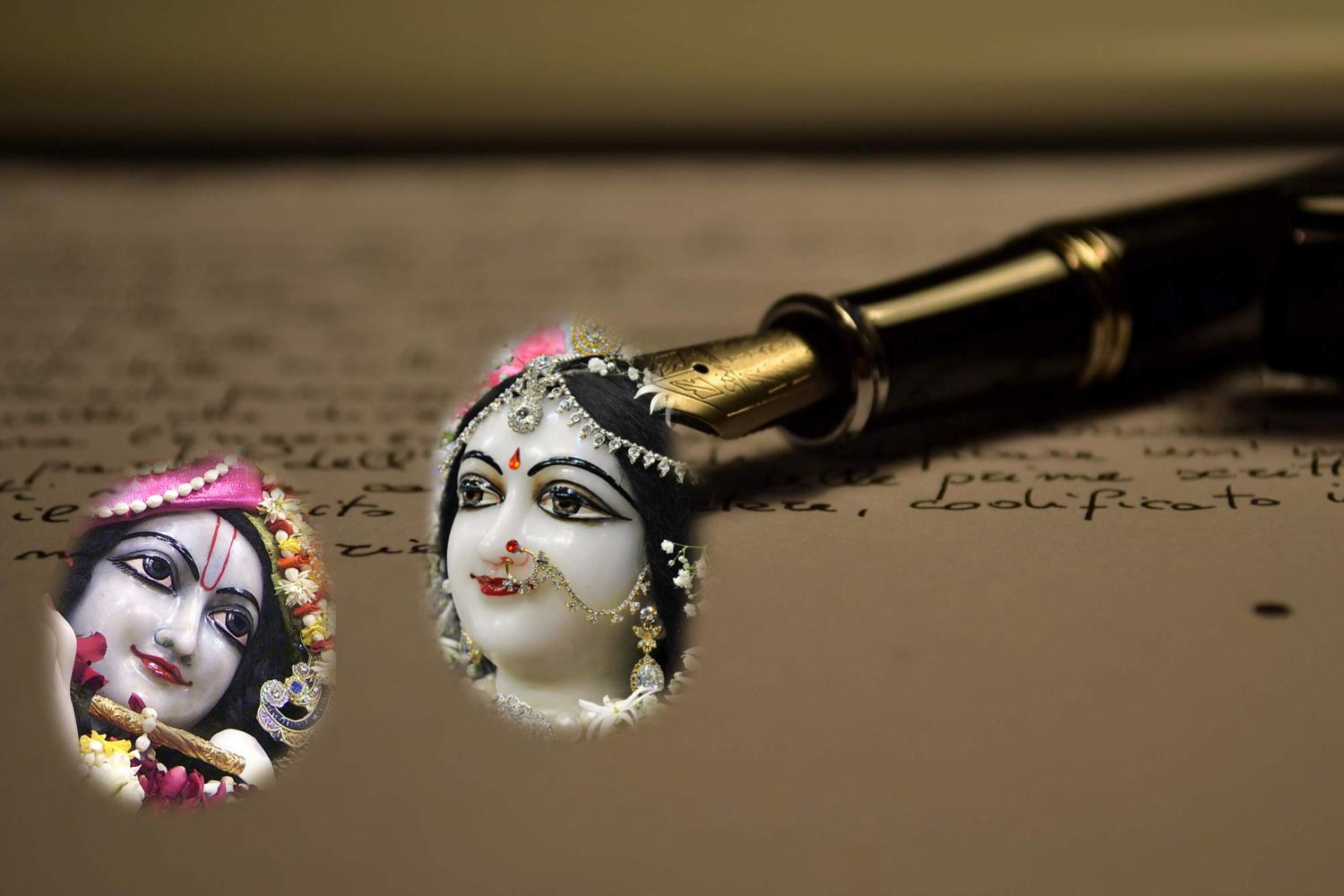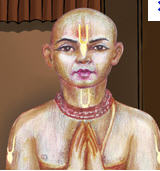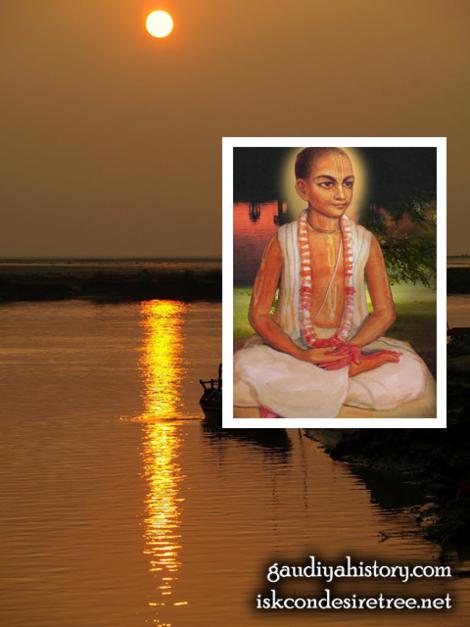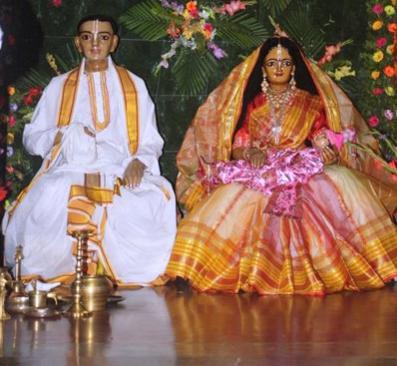
She was married to Jagannatha Mishra. After marriage she had eight daughters who died, followed by the birth of Vishvarupa and Vishvambhara. (In the image: Jagannath Mishra, Sachi Mata and little Nimai, Yoga Pitha, Mayapur).
She was the daughter of Nilambara Chakravarti and a resident of Belpukhuria. Nilambara had only one daughter and two sons, namely Yogeshvara and Ratnagarbha.
Sachi Devi's father had formerly been the cowherd Sumukha, who was Yashoda Devi's father. Sachi Devi's mother had formerly been Patala Devi, the wife of Sumukha in Krishna lila.
She was married to Jagannatha Mishra. After marriage she had eight daughters who died, followed by the birth of Vishvarupa and Vishvambhara.
Yashoda Devi and Vraja's king Nanda, who had been like two great oceans of the nectar of love for Krishna during the Lord's pastimes in Vrindavana, appeared during Lord Chaitanya's pastimes as Sachi Devi and Jagannatha Purandara. Some Devotees say that the two demigods Aditi and Kashyapa, who incarnated as Kaushalya and Dasharatha, Prshni and Sutapa, and also as Devaki and Vasudeva, the parents of Balarama and Krishna, also entered the bodies of Sachi Devi and Jagannatha. These Devotees say that if this were not so, then it would not have been possible for Balarama to take birth as their son Vishvarupa. (Shri Gaura Ganodesha Dipika by Shrila Kavi Karnapura 37, 38, 39, 105)
In his early youth Vishvarupa accepted sannyasa and renounced home. Shortly afterwards Jagannatha Mishra passed away. During this period, Lord Gauranga was Sachi's only solace. Sachi Devi was the embodiment of unlimited patience. She never became disturbed by the Her son's mischief.
After His return from Gaya, when Lord Gauranga began to act very unusually displaying symptoms of ecstatic love, Saci thought that perhaps her beloved Nimai was suffering from a mental disorder. Thus she arranged for medical treatment.
Once Lord Gauranga used his mother as an example to demonstrate to the people in general the seriousness of committing Vaishnava aparadha.
When Lord Chaitanya visited Shantipura after taking sannyasa, Sachi went to meet Him there. She stayed in Shantipura for sometime and cooked for Her son. It was at the request of Sachi that Lord Chaitanya settled at Nilachala. From Nilachala Lord Chaitanya regularly sent Jagannatha Prasada, clothes offered to the Deity and His humble obeisances to Sachi through messengers.
One feels amazed to see the humility of Sachi Devi, who was the highest ideal of a mother and a wife, who gave birth to Vishvarupa and Vishvambhara – both of whom accepted sannyasa for the welfare of the world, whose husband was the embodiment of spiritual merit, and whose two daughters-in-law were embodiments of Lakshmi. Sachi's entire household was dedicated to the service of Vishnu and Vaishnavas. She never hesitated to listen to and carry out the spiritual instructions given by her son, and her observance of the vow of Ekadashi and the repentance for her sin at the feet of Lord Advaita bear evidence to this fact. Despite hundreds of obstacles in her life, such as the death of her eight daughters, Vishvarupa embracing sannyasa, the death of Jagannatha Mishra, the death of Lakshmipriya her beloved daughter-in-law, Nimai accepting sannyasa, undergoing a state of destitution and utter helplessness, the problems of maintaining her young daughter-in-law, etc., yet Sachi never faltered from the path of spiritual life. She did not obstruct her son from accepting the sannyasa order. She never expected anything material from her son, whilst she received spiritual sustenance.
There are innumerable pastimes of Sachi in the biographies of Lord Chaitanya:
Chaitanya Bhagavata:
CBh. 1.2.139 states that Sachi assisted Jagannatha Mishra in his service to Lord Krishna. (GVA, CC. (R.G. N. Ed)
1.2.140 Sachi conceives Vishvarupa.
1.2.195-226 Lord Gauranga is conceived.
1.4.3-85 Performance of rituals on the occasion of Nimai's birth.
1.5.5-32 The sound of ankle-bells heard and the signs of divine footprints found throughout the house.
1.5.52, 1.6.41 Nimai eats the rice offered to the Lord by a visiting brahmana.
1.6.72-134 Olahana lila (chiding by Sachi).
1.7.34 Nimai sent to the house of Advaita Prabhu to call his elder brother.
1.7.74-114 Sachi's wailing when Vishvarupa took sannyasa.
1.7.151-192 Nimai sits on the vessel left on top of the garbage.
1.8.8-24 Nimai undergoes the sacred-thread ceremony.
1.8.109-119 Bereavement at the death of Jagannatha Mishra.
1.8.127-182 Nimai's annoyance with his mother at her delay in collecting items for Gangapuja.
1.10.47-128 Preparations for Nimai's marriage
1.12.214-255 Sachi hears the sound of the flute and the Lord reveals His opulence to her.
1.14.106-188 Bereavement of Sachi at the death of Lakshmipriya.
1.15.38, 1.17.406 Nimai's marriage with Vishnupriya.
2.2.88, 2,3,103 Lord Gauranga's transcendental state is mistaken as sickness.
2.8.68-122 Lord Gauranga and Lord Nityananda reveal
2.10.91, 2.11.67 Their opulence.
2.18.161,197,201
2.22.10-483 Sachi frees herself from Vaishnava-aparadha.
2.27.18-51 Sachi's state of mind when Lord Gauranga
2.28.60-65 accepted sannyasa.
3.1.38,50,146
3.2.262,
3.3.119,205
3.4.96,104,111
3.4.239,501 Sachi's visit to Santipura.
3.5.118
3.5.421, Lord Nityananda's arrival at Navadwipa and
3.9.170,219 meeting with Sachi.
Chaitanya Charitamrita:
1.15.10,29-30 Intake of rice on Ekadashi forbidden.
1.16.22-23
2.16.210, 3.1.14 Her meeting with Lord Chaitanya at the house of Advaita in Shantipura when the Lord was on His way to Ramakeli.
3.2.34,79 Divine appearance of Lord Chaitanya.
3.19.5-15 Sachi receives clothes sent by Lord Chaitanya through Jagadananda.
Chaitanya Mangala:
1.2.283-317 Sachi prevents Nimai from playing with a puppy.
1.5.143-157 Nimai consoles Sachi after the death of Laksmipriya by narrating a story about Laksmipriya's past birth.
2.5.5-13 Nimai tells Sachi about the vision He had in a dream of Lord Krishna.
3.3.27-55 Sachi's emotions about hearing of Lord Chaitanya's arrival at Navadwipa from Nilachala.
Advaita Prakasha :
Section ten explains how Advaita Acharya offered flowers to the feet of Lord Krishna and sang the praises of Sachi's pregnancy.

